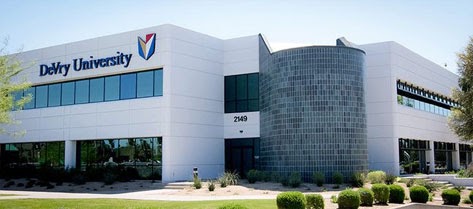For Americans, a college education is seen as a lifeline to the middle class. This is unsurprising- workers with a bachelor’s degree can expect to earn, on average, $17,500 more per year than high school graduates. In trying to remain in or reach the middle class, Americans of all ages try to earn college degrees by any means necessary. While many young students take what seems to be the traditional path- enrolling at a four year college directly after high school, this is a privilege that not everyone can afford. Thus enter for-profit colleges: institutions that function like businesses. They have shareholders, and market their product, which just happens to be education. For “non-traditional” students (think: those who are older, employed full-time, or parents), the claims made by for-profit institutions can seem like a path to new opportunities, touting quick paths to more rewarding and lucrative careers.
It’s not surprising that these institutions are overwhelmingly enticing to women and people of color, groups of people who already earn less compared to men and white people respectively. Many for-profit schools offer flexible opportunities like online classes, or courses that can be scheduled around the student’s schedule. For those who have to care for family or work full-time, these opportunities make an education seem more accessible than at traditional institutions of learning, which often conflict with the other numerous obligations of non-traditional students. While these schools seem to make higher education more accessible for a wider range of students, this could not be farther from the truth.

After serving in the military for four years, John Andrews was unsure of his next move and enrolled at the for-profit University of Phoenix. The University of Phoenix took advantage of funds from the GI Bill by enrolling Andrews, who ultimately ended up $40,000 in debt with a degree in business management that he is too embarrassed to display.
Jacqueta Cherry never completed high school, but longing for better career options, she responded to an advertisement for Everest University Online. Because of a melange of unfortunate circumstances, Cherry was unable to continue there. Soon after, she was pursued by other for-profit schools and eventually enrolled in the Art Institute of Pittsburgh’s online program. Cherry was never able to find a salaried job, and she remains one of many single mothers from these institutions with a combination of federal and private loans but without a diploma.
Students like Andrews and Cherry do not find themselves in these schools by accident- the marketing tactics of these institutions are extremely aggressive and are intended to get interested students to commit immediately. After agents convince a student to enroll, many institutions take care of all the details involved in enrolling them, including filling out financial aid paperwork. This means that many students enrolled are intentionally made unaware of the terms of their loans- even basic details such as whether the loans are private or federal. In recent years, for-profit colleges have garnered well-deserved attention for preying on students and making exaggerated or false claims that attending them will improve their job prospects.
In addition to preying disproportionately on women and people of color, some of these for-profit institutions even recruit on or near military bases, preying on the vulnerabilities of active-duty troops who are unsure of their career plans after their tours end. The GI Bill, which provides federal funds to finance the education of veterans, is a huge contributor to the aggressive marketing tactics of these schools. The predatory recruiting policies of veterans by for-profit institutions make one thing clear: these schools see veterans as nothing more than meal tickets, exploiting them to secure taxpayer dollars.
In 2009, only 12% of post-secondary enrollments were attributed to these for-profit institutions, yet accounted for an alarming 44% of federal student loan defaults. Students who manage to complete degrees from these institutions (less than a quarter of those who enroll), finish with around $8000 more debt than their peers at traditional colleges and universities. While some certificate programs can lead to employment for those who complete them, they by and large earn less and have more debt than their peers who completed comparable programs at public, not-for-profit institutions. By any standards, this is a worse outcome. For the graduates of these schools, who are overwhelmingly women of color, this is a huge additional burden for a group that already suffers significant discrimination in the workforce. This discrimination is not financially insignificant- on average, black women earn 39% less than white men.
Job prospects are bleak for the students who manage to graduate from these predatory institutions. Prior to enrolling, prospective students are convinced that earning a degree from them will provide them with better career opportunities. This could not be further from the truth. Students who graduate from for-profit colleges are likely to end up with a myriad of private and public student loan debt and near-useless degrees that fails to further their career prospects.
Students who choose to attend for-profit institutions are not fools. They are simply people who wanted better careers and chose a path that seemed most accessible. While students considering post-secondary education should be encouraged to do as much research as possible, the fault lies with a lack of regulations regarding how educational programs are permitted to market themselves and a lack of restrictions on these predatory schools. In 2012 under the Obama administration, the federal government’s Health, Education, Labor and Pensions Committee recommended stronger oversight of these institutions, including making federal funds less accessible to them. In 2016, the US Department of Education announced new regulations on these “predatory institutions”, which would have included avenues for debt cancellation for affected students. Under the Trump administration, this plan was postponed indefinitely by Secretary of Education Betsy DeVos, who is now being sued by 160,000 defrauded students who are united by the non-profit group Project on Predatory Student Lending.
By quashing efforts to repay students who fell prey to for-profit colleges, DeVos makes clear that the American federal government does not care about predatory business practices that target marginalized Americans.
Whoever wins the presidential election in 2020 will play a huge role in deciding whether or not the millions of students who attended for-profit colleges will be able to receive any compensation. Democratic presidential candidates Elizabeth Warren and Bernie Sanders have made student debt forgiveness and the overarching issue of high education costs integral parts of their respective platforms. Regardless of political affiliation, one fact rings true to nearly everyone: higher education in the United States is prohibitively expensive and something needs to be done. Without substantial changes to the cost of college and the flexibility afforded to non-traditional students, people will continue to fall into the traps of predatory institutions. Non-traditional students deserve a quality education that can lead to career opportunities, but this change will not happen without serious reform to the US education system.




